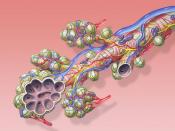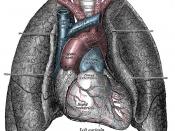The respiratory system of the horse is well adapted to athletic exercise, with unrestricted upper airway diameters, and a large lung capacity afforded by 18 ribs. These combine to enable air intakes of up to 1800 litres per minute in a galloping horse. Volumes of up to 300 litres of blood are pumped at high pressure through small lung capillaries surrounding 10 million air sacs to take up and deliver over 70 litres of oxygen per minute to the working muscles at the gallop.
As a result, any restriction in upper airway diameter, obstruction of the airways, diseases or stress related conditions that reduce efficiency of oxygen uptake from the air sacs, can have a great influence on athletic capacity.
The large lung surface and high blood flow rates also provide the additional function of heat loss during and after exercise, with up to 20% of the muscle heat generated during exercise being exchanged across the lung surface to supplement sweating and other skin surface heat loss mechanisms.
The respiratory system is continually challenged by a large amount of foreign material, including viruses, bacteria and fungi inhaled in air from track and arena surfaces during exercise, or from dusty bedding, feed and stable environments.
The horses circulatory system is a very large and complex system made up of veins and arteries. The blood is the pumped under enormous pressure from the heart along the arteries which have thick muscular walls to deal with the pressure. It oxygenates the body and the internal organs
The circulatory system is based upon the heart - a hollow, muscular organ in the chest cavity. It pumps the blood around the body and is divided into four separate compartments .
Blood from the right ventricle goes to the lungs to be oxygenated and then is...


